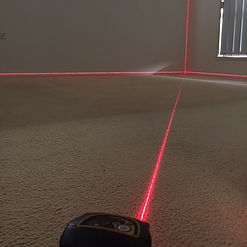How much can the soils under my house move?
During a pre-purchase building inspection on the Gold Coast, Brisbane, or Ipswich, where earth soils are extremely reactive, our building inspector uses a laser level application to determine if the floor is out of vertical alignment.
Our building inspector will provide advice in relation to any evidence of ground movement or out-of-level structures. At Premier Building and Pest Reports, we have inspected over 13,500 buildings and have regularly come across houses that are out of level. For example, in Burleigh Waters on the Gold Coast, there is a known pocket with excessive subsidence, where a large number of homes are tilting due to ground movement.
It’s important to note that the expected range of movement for residential buildings can vary based on the site classification. For Class A sites, there should be negligible movement, while Class H2 sites may experience significant movement. Homeowners should be aware of the site classification of their property and take appropriate measures to address any soil subsidence issues that may arise. If you suspect that your property is experiencing soil subsidence, it’s important to seek the advice of a qualified building inspector to assess the situation and recommend appropriate action.
The amount of movement that may occur depends on the site classification, which is defined under the Australian Standard AS2870.
The relevant classifications and expected movements under normal site conditions and seasonal influences are listed below.
Site classification Description of type of clay and reactivity expected range of movement:
| SITE CLASS | FOUNDATION | Characteristic Surface Movement |
| A | Mostly sand and rock with little or no ground movement from moisture changes is | Zero. 0 |
| S | Slightly reactive clays that do not present significant trouble. Very limited damage could be expected in the life of the building | 0 to 20mm |
| M | Moderately reactive clays that may cause minor movement and damage in the life of the building. Reasonable care is required in planning the site | 20 to 40mm |
| H1 | Highly reactive clay sites, which may experience high ground movement from moisture changes | 40 – 60mm |
| H2 | Highly reactive clay sites, which may experience very high ground movement from moisture changes | 60 – 75mm |
| E | Extremely reactive sites, which may experience extreme ground movement from moisture changes | > 75mm |
| P | Sites which include filled sites (refer to AS 2870 2.4.6), soft soils, such as soft clay or silt or loose sands; landslip; mine subsidence; collapsing soils; soils subject to erosion; reactive sites subject to abnormal moisture conditions or sites which cannot be classified otherwise |

